Literature Review: Asthma Control and Its Achievability
VerifiedAdded on 2020/10/22
|9
|2933
|493
Literature Review
AI Summary
This literature review examines the complexities of asthma control, emphasizing the importance of patient adherence, environmental factors, and comorbidities. It explores the challenges in achieving control, including factors leading to uncontrolled asthma, such as exposure to allergens and non-adherence to medication. The review highlights the risks associated with asthma, including workplace hazards and psychological factors like anxiety and depression. It also discusses the assessment of asthma control, the role of communication between physicians and patients, and the significance of proper training for healthcare professionals. The review underscores the need for proactive management strategies, including the use of inhalers, avoiding triggers, and addressing both physiological and behavioral aspects of the disease to improve patient outcomes and make asthma control an achievable goal. The review emphasizes the need for controlling environmental factors like air pollution, and the importance of patient-physician communication to assess and manage the disease effectively.

ASTHMA CONTROL:
STILL AN ACHIEVABLE
GOAL?
STILL AN ACHIEVABLE
GOAL?
Paraphrase This Document
Need a fresh take? Get an instant paraphrase of this document with our AI Paraphraser
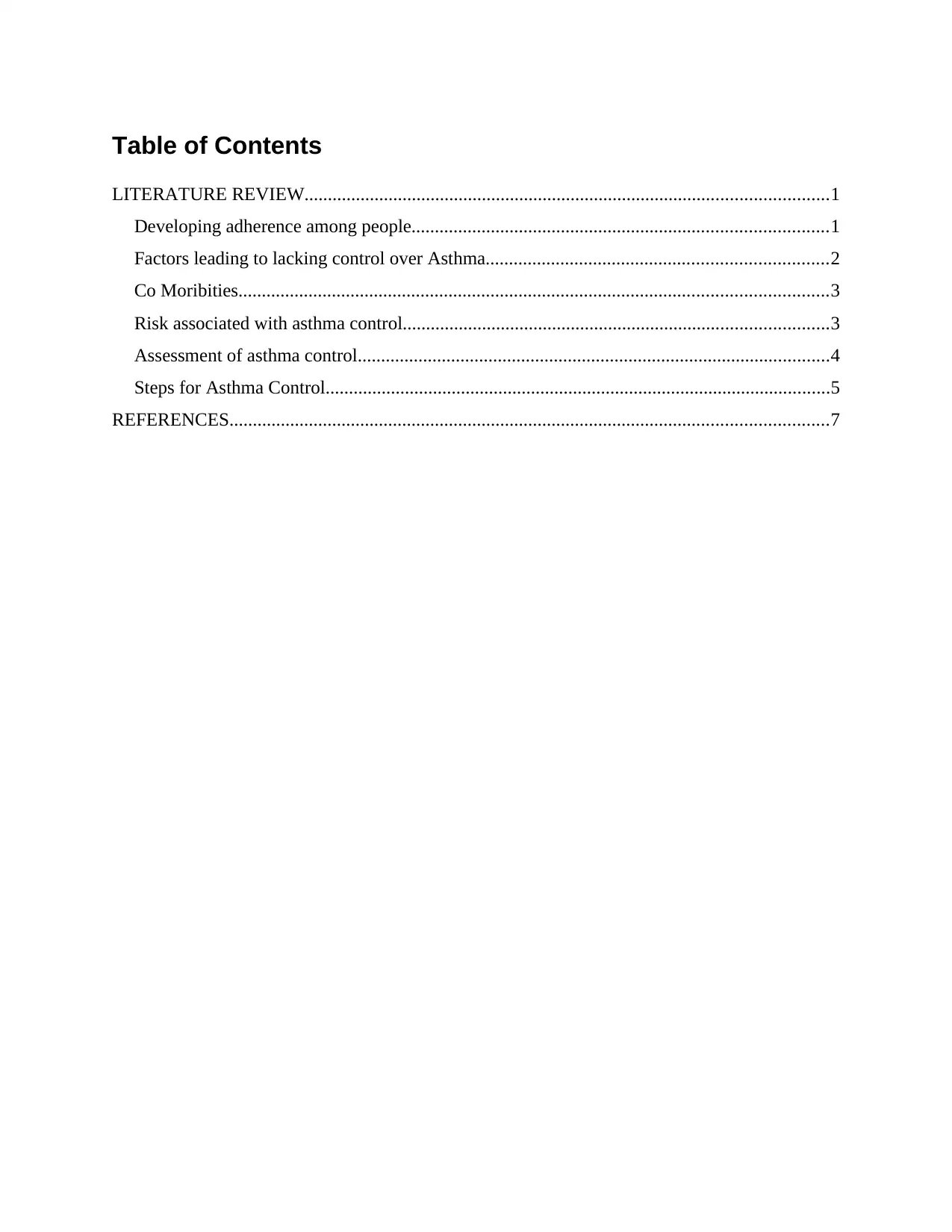
Table of Contents
LITERATURE REVIEW................................................................................................................1
Developing adherence among people.........................................................................................1
Factors leading to lacking control over Asthma.........................................................................2
Co Moribities..............................................................................................................................3
Risk associated with asthma control...........................................................................................3
Assessment of asthma control.....................................................................................................4
Steps for Asthma Control............................................................................................................5
REFERENCES................................................................................................................................7
LITERATURE REVIEW................................................................................................................1
Developing adherence among people.........................................................................................1
Factors leading to lacking control over Asthma.........................................................................2
Co Moribities..............................................................................................................................3
Risk associated with asthma control...........................................................................................3
Assessment of asthma control.....................................................................................................4
Steps for Asthma Control............................................................................................................5
REFERENCES................................................................................................................................7
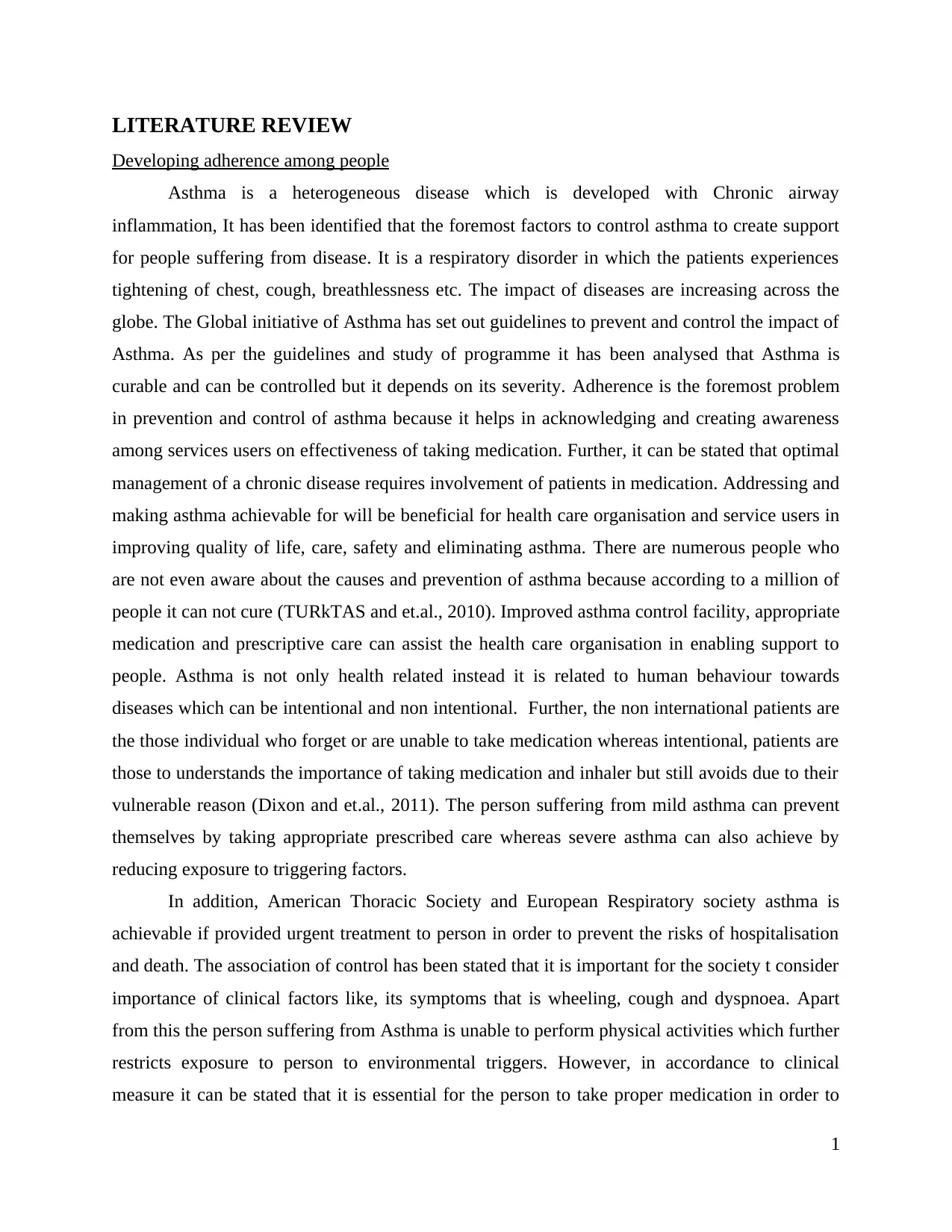
LITERATURE REVIEW
Developing adherence among people
Asthma is a heterogeneous disease which is developed with Chronic airway
inflammation, It has been identified that the foremost factors to control asthma to create support
for people suffering from disease. It is a respiratory disorder in which the patients experiences
tightening of chest, cough, breathlessness etc. The impact of diseases are increasing across the
globe. The Global initiative of Asthma has set out guidelines to prevent and control the impact of
Asthma. As per the guidelines and study of programme it has been analysed that Asthma is
curable and can be controlled but it depends on its severity. Adherence is the foremost problem
in prevention and control of asthma because it helps in acknowledging and creating awareness
among services users on effectiveness of taking medication. Further, it can be stated that optimal
management of a chronic disease requires involvement of patients in medication. Addressing and
making asthma achievable for will be beneficial for health care organisation and service users in
improving quality of life, care, safety and eliminating asthma. There are numerous people who
are not even aware about the causes and prevention of asthma because according to a million of
people it can not cure (TURkTAS and et.al., 2010). Improved asthma control facility, appropriate
medication and prescriptive care can assist the health care organisation in enabling support to
people. Asthma is not only health related instead it is related to human behaviour towards
diseases which can be intentional and non intentional. Further, the non international patients are
the those individual who forget or are unable to take medication whereas intentional, patients are
those to understands the importance of taking medication and inhaler but still avoids due to their
vulnerable reason (Dixon and et.al., 2011). The person suffering from mild asthma can prevent
themselves by taking appropriate prescribed care whereas severe asthma can also achieve by
reducing exposure to triggering factors.
In addition, American Thoracic Society and European Respiratory society asthma is
achievable if provided urgent treatment to person in order to prevent the risks of hospitalisation
and death. The association of control has been stated that it is important for the society t consider
importance of clinical factors like, its symptoms that is wheeling, cough and dyspnoea. Apart
from this the person suffering from Asthma is unable to perform physical activities which further
restricts exposure to person to environmental triggers. However, in accordance to clinical
measure it can be stated that it is essential for the person to take proper medication in order to
1
Developing adherence among people
Asthma is a heterogeneous disease which is developed with Chronic airway
inflammation, It has been identified that the foremost factors to control asthma to create support
for people suffering from disease. It is a respiratory disorder in which the patients experiences
tightening of chest, cough, breathlessness etc. The impact of diseases are increasing across the
globe. The Global initiative of Asthma has set out guidelines to prevent and control the impact of
Asthma. As per the guidelines and study of programme it has been analysed that Asthma is
curable and can be controlled but it depends on its severity. Adherence is the foremost problem
in prevention and control of asthma because it helps in acknowledging and creating awareness
among services users on effectiveness of taking medication. Further, it can be stated that optimal
management of a chronic disease requires involvement of patients in medication. Addressing and
making asthma achievable for will be beneficial for health care organisation and service users in
improving quality of life, care, safety and eliminating asthma. There are numerous people who
are not even aware about the causes and prevention of asthma because according to a million of
people it can not cure (TURkTAS and et.al., 2010). Improved asthma control facility, appropriate
medication and prescriptive care can assist the health care organisation in enabling support to
people. Asthma is not only health related instead it is related to human behaviour towards
diseases which can be intentional and non intentional. Further, the non international patients are
the those individual who forget or are unable to take medication whereas intentional, patients are
those to understands the importance of taking medication and inhaler but still avoids due to their
vulnerable reason (Dixon and et.al., 2011). The person suffering from mild asthma can prevent
themselves by taking appropriate prescribed care whereas severe asthma can also achieve by
reducing exposure to triggering factors.
In addition, American Thoracic Society and European Respiratory society asthma is
achievable if provided urgent treatment to person in order to prevent the risks of hospitalisation
and death. The association of control has been stated that it is important for the society t consider
importance of clinical factors like, its symptoms that is wheeling, cough and dyspnoea. Apart
from this the person suffering from Asthma is unable to perform physical activities which further
restricts exposure to person to environmental triggers. However, in accordance to clinical
measure it can be stated that it is essential for the person to take proper medication in order to
1
⊘ This is a preview!⊘
Do you want full access?
Subscribe today to unlock all pages.

Trusted by 1+ million students worldwide
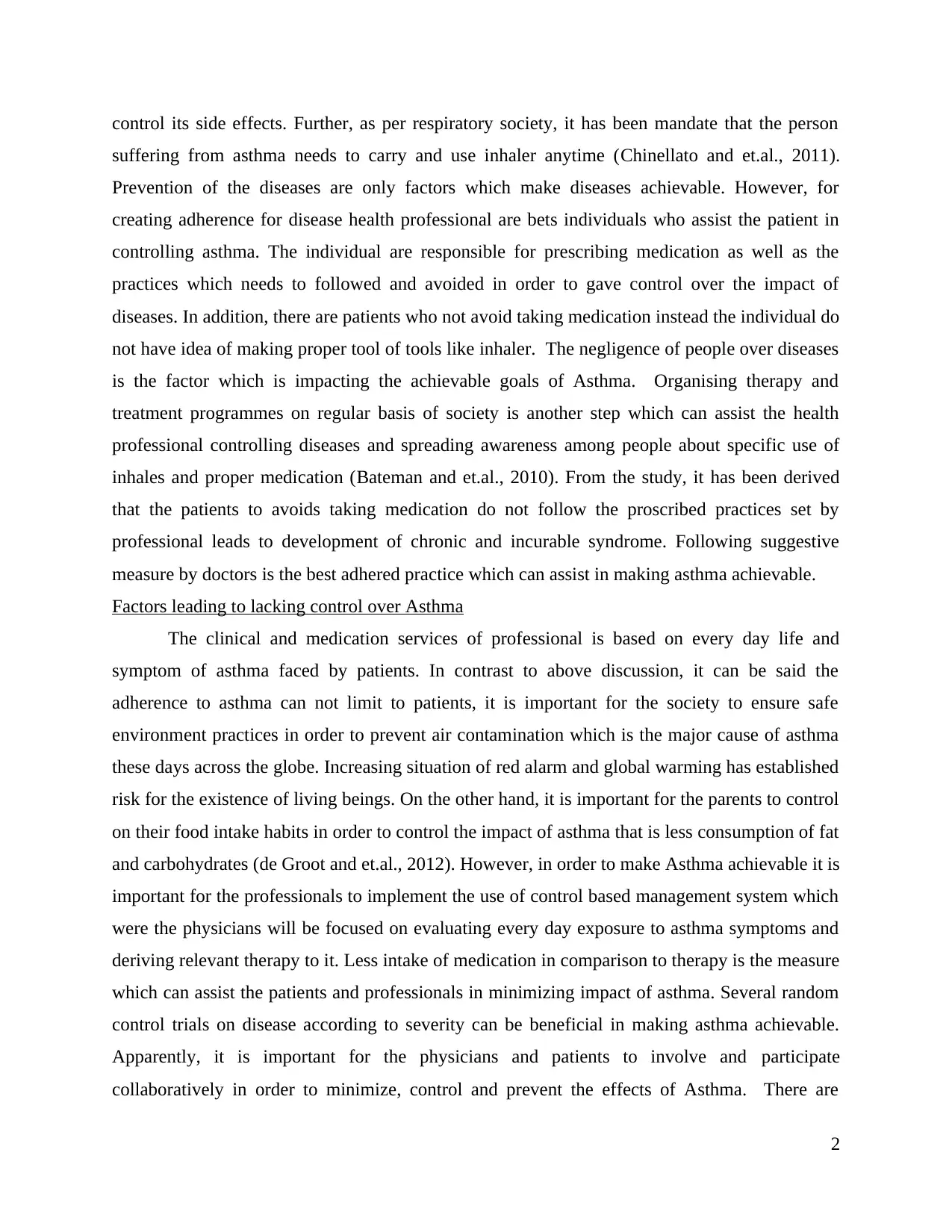
control its side effects. Further, as per respiratory society, it has been mandate that the person
suffering from asthma needs to carry and use inhaler anytime (Chinellato and et.al., 2011).
Prevention of the diseases are only factors which make diseases achievable. However, for
creating adherence for disease health professional are bets individuals who assist the patient in
controlling asthma. The individual are responsible for prescribing medication as well as the
practices which needs to followed and avoided in order to gave control over the impact of
diseases. In addition, there are patients who not avoid taking medication instead the individual do
not have idea of making proper tool of tools like inhaler. The negligence of people over diseases
is the factor which is impacting the achievable goals of Asthma. Organising therapy and
treatment programmes on regular basis of society is another step which can assist the health
professional controlling diseases and spreading awareness among people about specific use of
inhales and proper medication (Bateman and et.al., 2010). From the study, it has been derived
that the patients to avoids taking medication do not follow the proscribed practices set by
professional leads to development of chronic and incurable syndrome. Following suggestive
measure by doctors is the best adhered practice which can assist in making asthma achievable.
Factors leading to lacking control over Asthma
The clinical and medication services of professional is based on every day life and
symptom of asthma faced by patients. In contrast to above discussion, it can be said the
adherence to asthma can not limit to patients, it is important for the society to ensure safe
environment practices in order to prevent air contamination which is the major cause of asthma
these days across the globe. Increasing situation of red alarm and global warming has established
risk for the existence of living beings. On the other hand, it is important for the parents to control
on their food intake habits in order to control the impact of asthma that is less consumption of fat
and carbohydrates (de Groot and et.al., 2012). However, in order to make Asthma achievable it is
important for the professionals to implement the use of control based management system which
were the physicians will be focused on evaluating every day exposure to asthma symptoms and
deriving relevant therapy to it. Less intake of medication in comparison to therapy is the measure
which can assist the patients and professionals in minimizing impact of asthma. Several random
control trials on disease according to severity can be beneficial in making asthma achievable.
Apparently, it is important for the physicians and patients to involve and participate
collaboratively in order to minimize, control and prevent the effects of Asthma. There are
2
suffering from asthma needs to carry and use inhaler anytime (Chinellato and et.al., 2011).
Prevention of the diseases are only factors which make diseases achievable. However, for
creating adherence for disease health professional are bets individuals who assist the patient in
controlling asthma. The individual are responsible for prescribing medication as well as the
practices which needs to followed and avoided in order to gave control over the impact of
diseases. In addition, there are patients who not avoid taking medication instead the individual do
not have idea of making proper tool of tools like inhaler. The negligence of people over diseases
is the factor which is impacting the achievable goals of Asthma. Organising therapy and
treatment programmes on regular basis of society is another step which can assist the health
professional controlling diseases and spreading awareness among people about specific use of
inhales and proper medication (Bateman and et.al., 2010). From the study, it has been derived
that the patients to avoids taking medication do not follow the proscribed practices set by
professional leads to development of chronic and incurable syndrome. Following suggestive
measure by doctors is the best adhered practice which can assist in making asthma achievable.
Factors leading to lacking control over Asthma
The clinical and medication services of professional is based on every day life and
symptom of asthma faced by patients. In contrast to above discussion, it can be said the
adherence to asthma can not limit to patients, it is important for the society to ensure safe
environment practices in order to prevent air contamination which is the major cause of asthma
these days across the globe. Increasing situation of red alarm and global warming has established
risk for the existence of living beings. On the other hand, it is important for the parents to control
on their food intake habits in order to control the impact of asthma that is less consumption of fat
and carbohydrates (de Groot and et.al., 2012). However, in order to make Asthma achievable it is
important for the professionals to implement the use of control based management system which
were the physicians will be focused on evaluating every day exposure to asthma symptoms and
deriving relevant therapy to it. Less intake of medication in comparison to therapy is the measure
which can assist the patients and professionals in minimizing impact of asthma. Several random
control trials on disease according to severity can be beneficial in making asthma achievable.
Apparently, it is important for the physicians and patients to involve and participate
collaboratively in order to minimize, control and prevent the effects of Asthma. There are
2
Paraphrase This Document
Need a fresh take? Get an instant paraphrase of this document with our AI Paraphraser
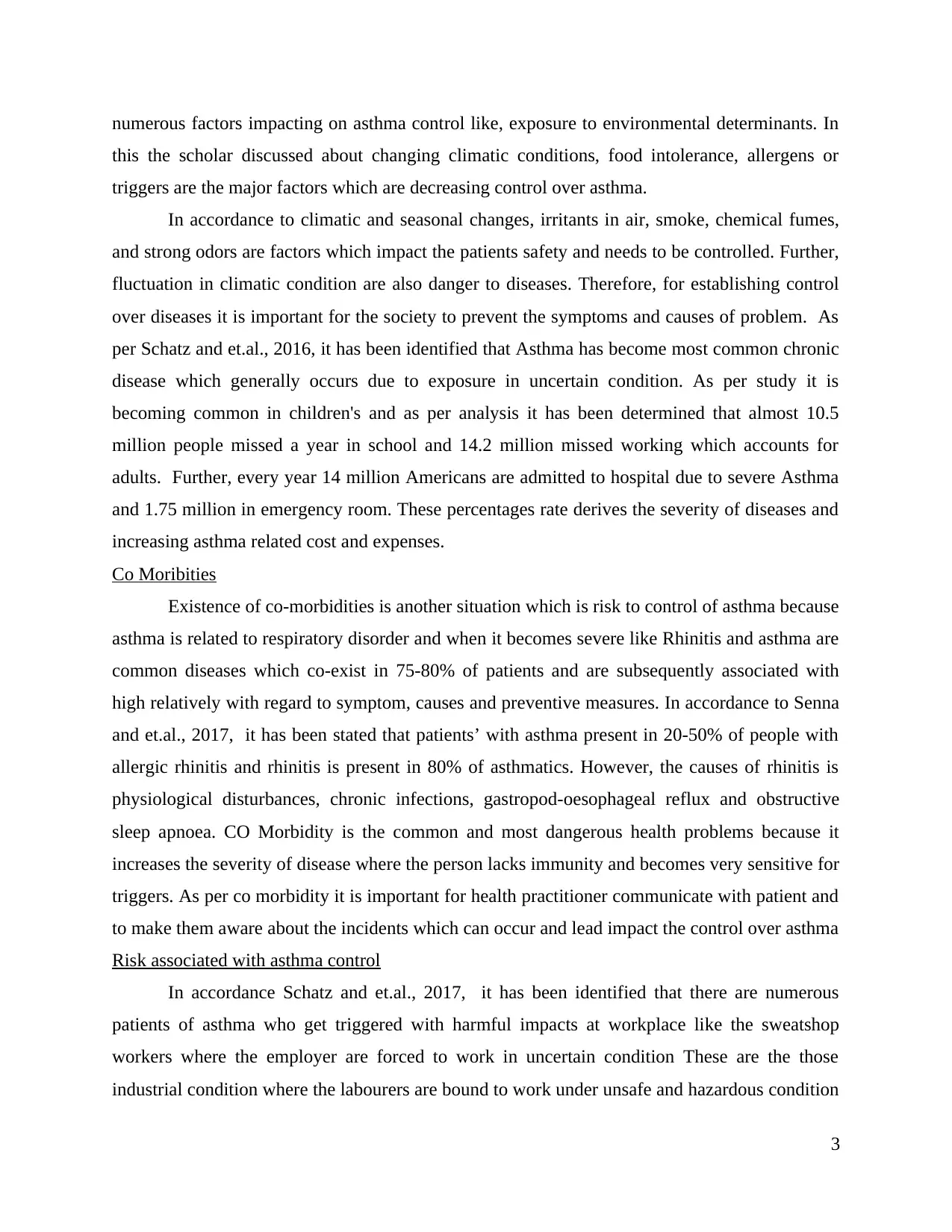
numerous factors impacting on asthma control like, exposure to environmental determinants. In
this the scholar discussed about changing climatic conditions, food intolerance, allergens or
triggers are the major factors which are decreasing control over asthma.
In accordance to climatic and seasonal changes, irritants in air, smoke, chemical fumes,
and strong odors are factors which impact the patients safety and needs to be controlled. Further,
fluctuation in climatic condition are also danger to diseases. Therefore, for establishing control
over diseases it is important for the society to prevent the symptoms and causes of problem. As
per Schatz and et.al., 2016, it has been identified that Asthma has become most common chronic
disease which generally occurs due to exposure in uncertain condition. As per study it is
becoming common in children's and as per analysis it has been determined that almost 10.5
million people missed a year in school and 14.2 million missed working which accounts for
adults. Further, every year 14 million Americans are admitted to hospital due to severe Asthma
and 1.75 million in emergency room. These percentages rate derives the severity of diseases and
increasing asthma related cost and expenses.
Co Moribities
Existence of co-morbidities is another situation which is risk to control of asthma because
asthma is related to respiratory disorder and when it becomes severe like Rhinitis and asthma are
common diseases which co-exist in 75-80% of patients and are subsequently associated with
high relatively with regard to symptom, causes and preventive measures. In accordance to Senna
and et.al., 2017, it has been stated that patients’ with asthma present in 20-50% of people with
allergic rhinitis and rhinitis is present in 80% of asthmatics. However, the causes of rhinitis is
physiological disturbances, chronic infections, gastropod-oesophageal reflux and obstructive
sleep apnoea. CO Morbidity is the common and most dangerous health problems because it
increases the severity of disease where the person lacks immunity and becomes very sensitive for
triggers. As per co morbidity it is important for health practitioner communicate with patient and
to make them aware about the incidents which can occur and lead impact the control over asthma
Risk associated with asthma control
In accordance Schatz and et.al., 2017, it has been identified that there are numerous
patients of asthma who get triggered with harmful impacts at workplace like the sweatshop
workers where the employer are forced to work in uncertain condition These are the those
industrial condition where the labourers are bound to work under unsafe and hazardous condition
3
this the scholar discussed about changing climatic conditions, food intolerance, allergens or
triggers are the major factors which are decreasing control over asthma.
In accordance to climatic and seasonal changes, irritants in air, smoke, chemical fumes,
and strong odors are factors which impact the patients safety and needs to be controlled. Further,
fluctuation in climatic condition are also danger to diseases. Therefore, for establishing control
over diseases it is important for the society to prevent the symptoms and causes of problem. As
per Schatz and et.al., 2016, it has been identified that Asthma has become most common chronic
disease which generally occurs due to exposure in uncertain condition. As per study it is
becoming common in children's and as per analysis it has been determined that almost 10.5
million people missed a year in school and 14.2 million missed working which accounts for
adults. Further, every year 14 million Americans are admitted to hospital due to severe Asthma
and 1.75 million in emergency room. These percentages rate derives the severity of diseases and
increasing asthma related cost and expenses.
Co Moribities
Existence of co-morbidities is another situation which is risk to control of asthma because
asthma is related to respiratory disorder and when it becomes severe like Rhinitis and asthma are
common diseases which co-exist in 75-80% of patients and are subsequently associated with
high relatively with regard to symptom, causes and preventive measures. In accordance to Senna
and et.al., 2017, it has been stated that patients’ with asthma present in 20-50% of people with
allergic rhinitis and rhinitis is present in 80% of asthmatics. However, the causes of rhinitis is
physiological disturbances, chronic infections, gastropod-oesophageal reflux and obstructive
sleep apnoea. CO Morbidity is the common and most dangerous health problems because it
increases the severity of disease where the person lacks immunity and becomes very sensitive for
triggers. As per co morbidity it is important for health practitioner communicate with patient and
to make them aware about the incidents which can occur and lead impact the control over asthma
Risk associated with asthma control
In accordance Schatz and et.al., 2017, it has been identified that there are numerous
patients of asthma who get triggered with harmful impacts at workplace like the sweatshop
workers where the employer are forced to work in uncertain condition These are the those
industrial condition where the labourers are bound to work under unsafe and hazardous condition
3
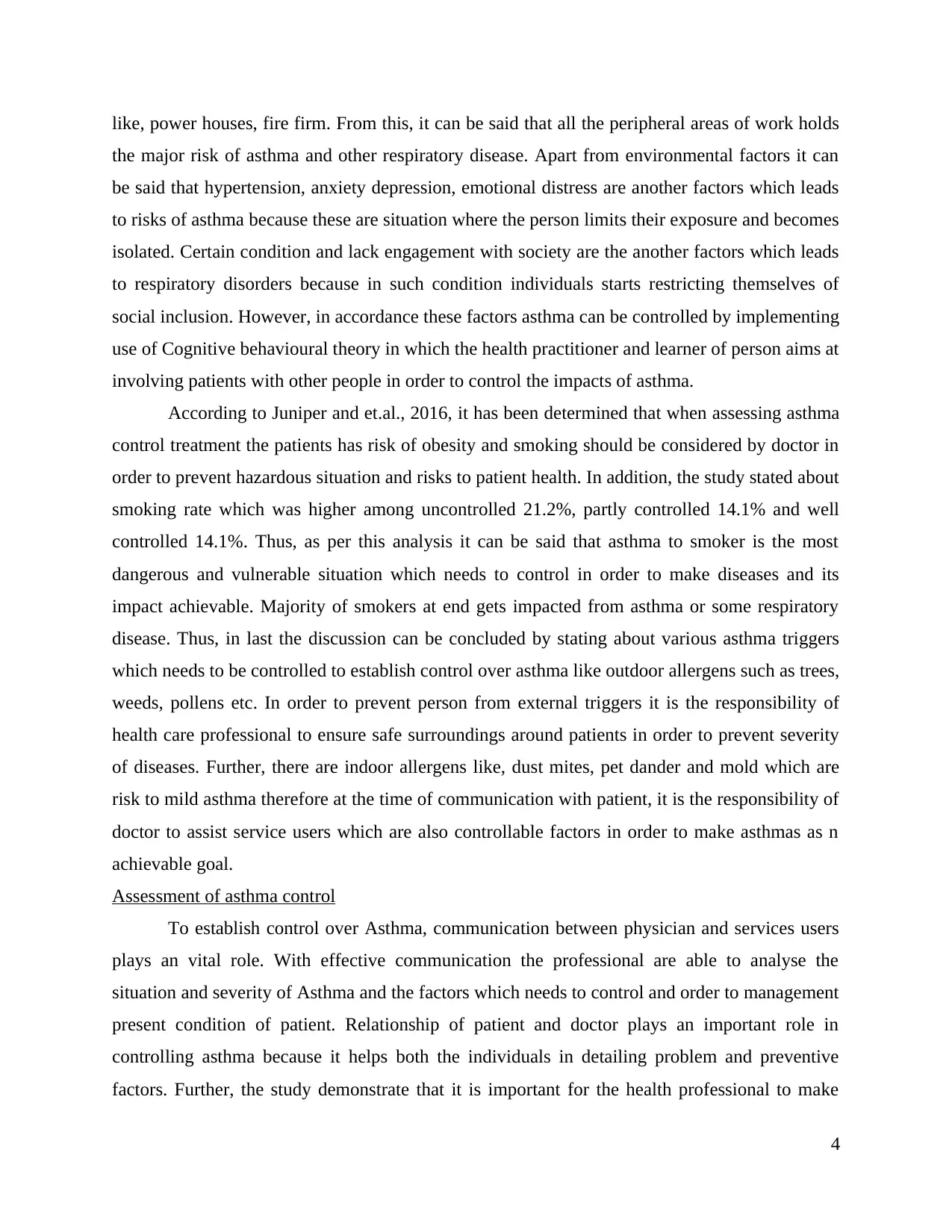
like, power houses, fire firm. From this, it can be said that all the peripheral areas of work holds
the major risk of asthma and other respiratory disease. Apart from environmental factors it can
be said that hypertension, anxiety depression, emotional distress are another factors which leads
to risks of asthma because these are situation where the person limits their exposure and becomes
isolated. Certain condition and lack engagement with society are the another factors which leads
to respiratory disorders because in such condition individuals starts restricting themselves of
social inclusion. However, in accordance these factors asthma can be controlled by implementing
use of Cognitive behavioural theory in which the health practitioner and learner of person aims at
involving patients with other people in order to control the impacts of asthma.
According to Juniper and et.al., 2016, it has been determined that when assessing asthma
control treatment the patients has risk of obesity and smoking should be considered by doctor in
order to prevent hazardous situation and risks to patient health. In addition, the study stated about
smoking rate which was higher among uncontrolled 21.2%, partly controlled 14.1% and well
controlled 14.1%. Thus, as per this analysis it can be said that asthma to smoker is the most
dangerous and vulnerable situation which needs to control in order to make diseases and its
impact achievable. Majority of smokers at end gets impacted from asthma or some respiratory
disease. Thus, in last the discussion can be concluded by stating about various asthma triggers
which needs to be controlled to establish control over asthma like outdoor allergens such as trees,
weeds, pollens etc. In order to prevent person from external triggers it is the responsibility of
health care professional to ensure safe surroundings around patients in order to prevent severity
of diseases. Further, there are indoor allergens like, dust mites, pet dander and mold which are
risk to mild asthma therefore at the time of communication with patient, it is the responsibility of
doctor to assist service users which are also controllable factors in order to make asthmas as n
achievable goal.
Assessment of asthma control
To establish control over Asthma, communication between physician and services users
plays an vital role. With effective communication the professional are able to analyse the
situation and severity of Asthma and the factors which needs to control and order to management
present condition of patient. Relationship of patient and doctor plays an important role in
controlling asthma because it helps both the individuals in detailing problem and preventive
factors. Further, the study demonstrate that it is important for the health professional to make
4
the major risk of asthma and other respiratory disease. Apart from environmental factors it can
be said that hypertension, anxiety depression, emotional distress are another factors which leads
to risks of asthma because these are situation where the person limits their exposure and becomes
isolated. Certain condition and lack engagement with society are the another factors which leads
to respiratory disorders because in such condition individuals starts restricting themselves of
social inclusion. However, in accordance these factors asthma can be controlled by implementing
use of Cognitive behavioural theory in which the health practitioner and learner of person aims at
involving patients with other people in order to control the impacts of asthma.
According to Juniper and et.al., 2016, it has been determined that when assessing asthma
control treatment the patients has risk of obesity and smoking should be considered by doctor in
order to prevent hazardous situation and risks to patient health. In addition, the study stated about
smoking rate which was higher among uncontrolled 21.2%, partly controlled 14.1% and well
controlled 14.1%. Thus, as per this analysis it can be said that asthma to smoker is the most
dangerous and vulnerable situation which needs to control in order to make diseases and its
impact achievable. Majority of smokers at end gets impacted from asthma or some respiratory
disease. Thus, in last the discussion can be concluded by stating about various asthma triggers
which needs to be controlled to establish control over asthma like outdoor allergens such as trees,
weeds, pollens etc. In order to prevent person from external triggers it is the responsibility of
health care professional to ensure safe surroundings around patients in order to prevent severity
of diseases. Further, there are indoor allergens like, dust mites, pet dander and mold which are
risk to mild asthma therefore at the time of communication with patient, it is the responsibility of
doctor to assist service users which are also controllable factors in order to make asthmas as n
achievable goal.
Assessment of asthma control
To establish control over Asthma, communication between physician and services users
plays an vital role. With effective communication the professional are able to analyse the
situation and severity of Asthma and the factors which needs to control and order to management
present condition of patient. Relationship of patient and doctor plays an important role in
controlling asthma because it helps both the individuals in detailing problem and preventive
factors. Further, the study demonstrate that it is important for the health professional to make
4
⊘ This is a preview!⊘
Do you want full access?
Subscribe today to unlock all pages.

Trusted by 1+ million students worldwide
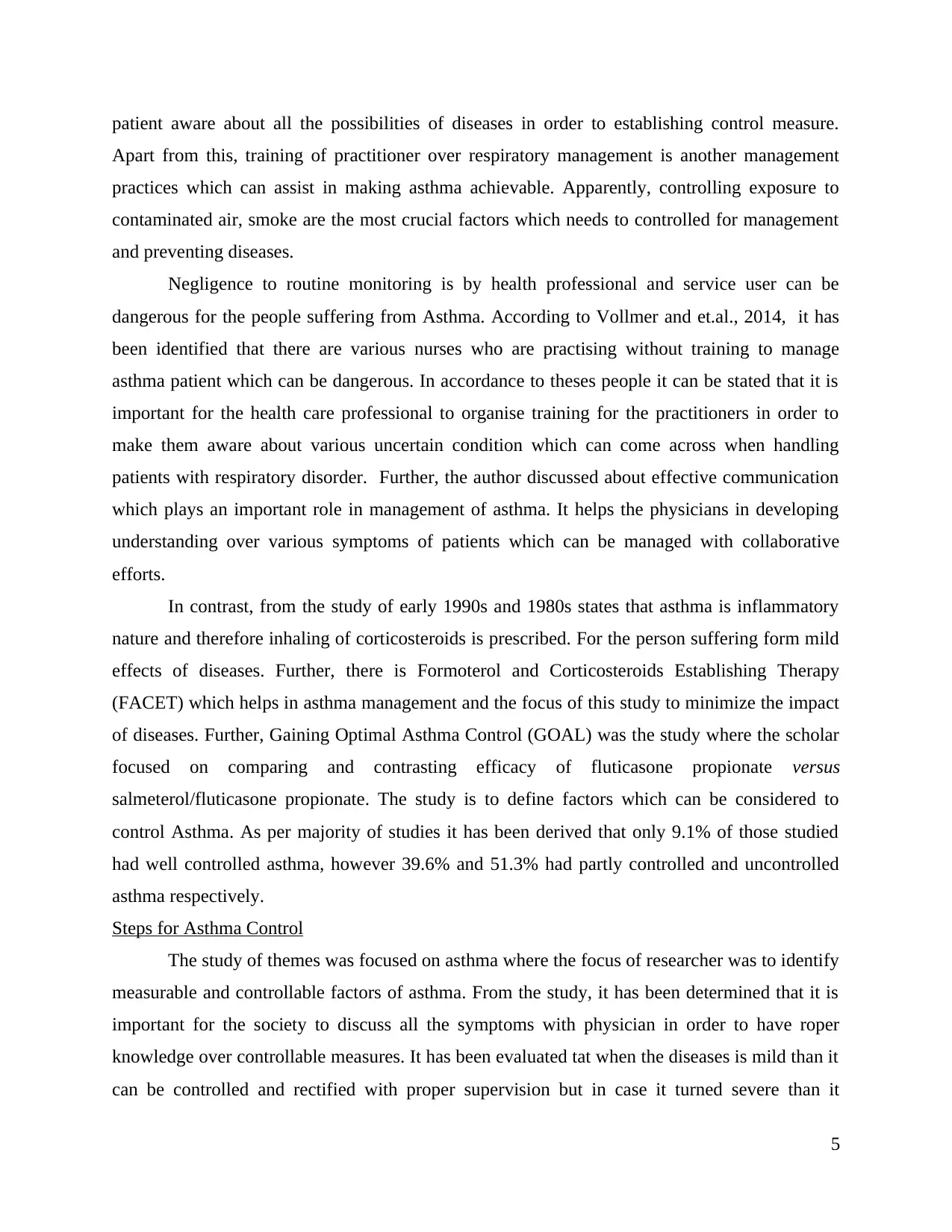
patient aware about all the possibilities of diseases in order to establishing control measure.
Apart from this, training of practitioner over respiratory management is another management
practices which can assist in making asthma achievable. Apparently, controlling exposure to
contaminated air, smoke are the most crucial factors which needs to controlled for management
and preventing diseases.
Negligence to routine monitoring is by health professional and service user can be
dangerous for the people suffering from Asthma. According to Vollmer and et.al., 2014, it has
been identified that there are various nurses who are practising without training to manage
asthma patient which can be dangerous. In accordance to theses people it can be stated that it is
important for the health care professional to organise training for the practitioners in order to
make them aware about various uncertain condition which can come across when handling
patients with respiratory disorder. Further, the author discussed about effective communication
which plays an important role in management of asthma. It helps the physicians in developing
understanding over various symptoms of patients which can be managed with collaborative
efforts.
In contrast, from the study of early 1990s and 1980s states that asthma is inflammatory
nature and therefore inhaling of corticosteroids is prescribed. For the person suffering form mild
effects of diseases. Further, there is Formoterol and Corticosteroids Establishing Therapy
(FACET) which helps in asthma management and the focus of this study to minimize the impact
of diseases. Further, Gaining Optimal Asthma Control (GOAL) was the study where the scholar
focused on comparing and contrasting efficacy of fluticasone propionate versus
salmeterol/fluticasone propionate. The study is to define factors which can be considered to
control Asthma. As per majority of studies it has been derived that only 9.1% of those studied
had well controlled asthma, however 39.6% and 51.3% had partly controlled and uncontrolled
asthma respectively.
Steps for Asthma Control
The study of themes was focused on asthma where the focus of researcher was to identify
measurable and controllable factors of asthma. From the study, it has been determined that it is
important for the society to discuss all the symptoms with physician in order to have roper
knowledge over controllable measures. It has been evaluated tat when the diseases is mild than it
can be controlled and rectified with proper supervision but in case it turned severe than it
5
Apart from this, training of practitioner over respiratory management is another management
practices which can assist in making asthma achievable. Apparently, controlling exposure to
contaminated air, smoke are the most crucial factors which needs to controlled for management
and preventing diseases.
Negligence to routine monitoring is by health professional and service user can be
dangerous for the people suffering from Asthma. According to Vollmer and et.al., 2014, it has
been identified that there are various nurses who are practising without training to manage
asthma patient which can be dangerous. In accordance to theses people it can be stated that it is
important for the health care professional to organise training for the practitioners in order to
make them aware about various uncertain condition which can come across when handling
patients with respiratory disorder. Further, the author discussed about effective communication
which plays an important role in management of asthma. It helps the physicians in developing
understanding over various symptoms of patients which can be managed with collaborative
efforts.
In contrast, from the study of early 1990s and 1980s states that asthma is inflammatory
nature and therefore inhaling of corticosteroids is prescribed. For the person suffering form mild
effects of diseases. Further, there is Formoterol and Corticosteroids Establishing Therapy
(FACET) which helps in asthma management and the focus of this study to minimize the impact
of diseases. Further, Gaining Optimal Asthma Control (GOAL) was the study where the scholar
focused on comparing and contrasting efficacy of fluticasone propionate versus
salmeterol/fluticasone propionate. The study is to define factors which can be considered to
control Asthma. As per majority of studies it has been derived that only 9.1% of those studied
had well controlled asthma, however 39.6% and 51.3% had partly controlled and uncontrolled
asthma respectively.
Steps for Asthma Control
The study of themes was focused on asthma where the focus of researcher was to identify
measurable and controllable factors of asthma. From the study, it has been determined that it is
important for the society to discuss all the symptoms with physician in order to have roper
knowledge over controllable measures. It has been evaluated tat when the diseases is mild than it
can be controlled and rectified with proper supervision but in case it turned severe than it
5
Paraphrase This Document
Need a fresh take? Get an instant paraphrase of this document with our AI Paraphraser
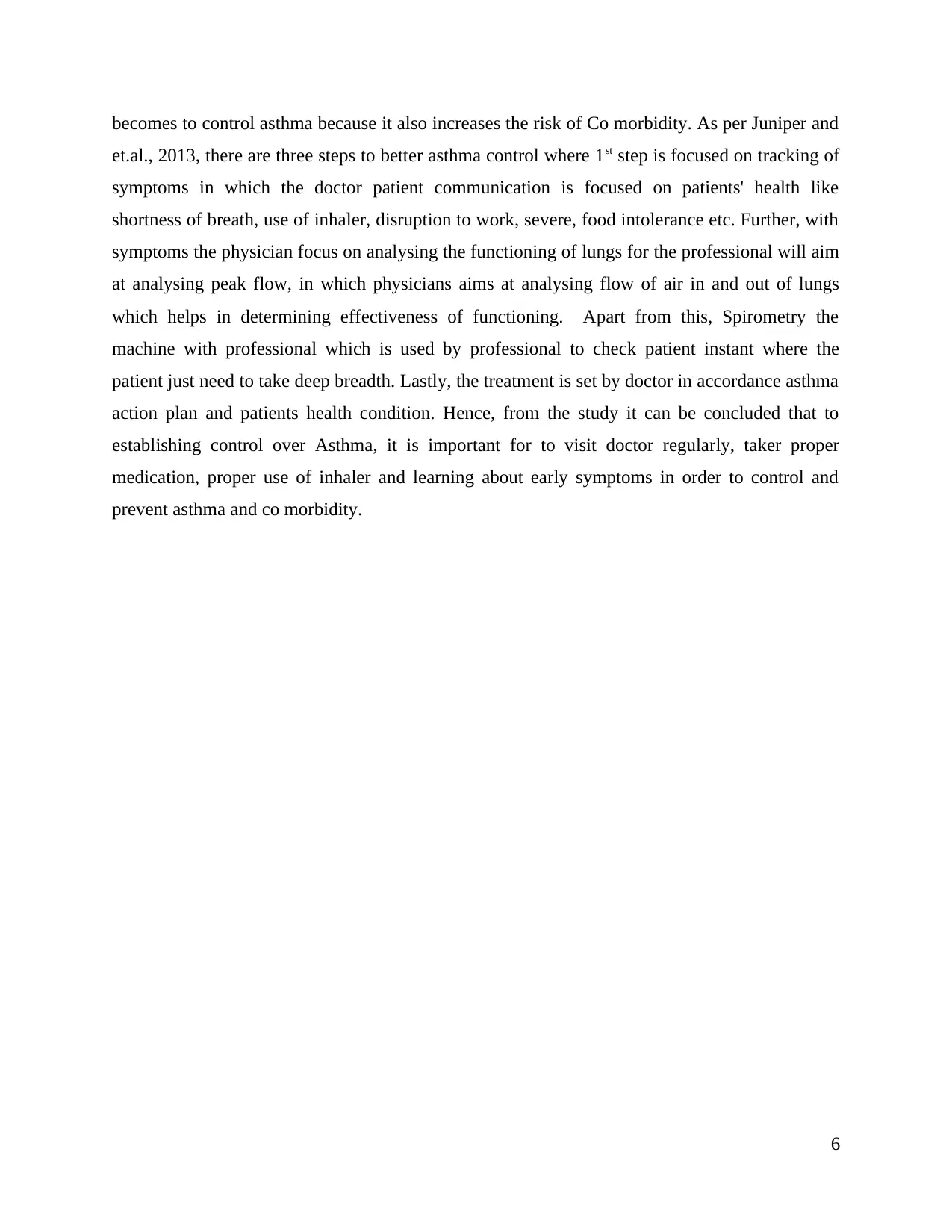
becomes to control asthma because it also increases the risk of Co morbidity. As per Juniper and
et.al., 2013, there are three steps to better asthma control where 1st step is focused on tracking of
symptoms in which the doctor patient communication is focused on patients' health like
shortness of breath, use of inhaler, disruption to work, severe, food intolerance etc. Further, with
symptoms the physician focus on analysing the functioning of lungs for the professional will aim
at analysing peak flow, in which physicians aims at analysing flow of air in and out of lungs
which helps in determining effectiveness of functioning. Apart from this, Spirometry the
machine with professional which is used by professional to check patient instant where the
patient just need to take deep breadth. Lastly, the treatment is set by doctor in accordance asthma
action plan and patients health condition. Hence, from the study it can be concluded that to
establishing control over Asthma, it is important for to visit doctor regularly, taker proper
medication, proper use of inhaler and learning about early symptoms in order to control and
prevent asthma and co morbidity.
6
et.al., 2013, there are three steps to better asthma control where 1st step is focused on tracking of
symptoms in which the doctor patient communication is focused on patients' health like
shortness of breath, use of inhaler, disruption to work, severe, food intolerance etc. Further, with
symptoms the physician focus on analysing the functioning of lungs for the professional will aim
at analysing peak flow, in which physicians aims at analysing flow of air in and out of lungs
which helps in determining effectiveness of functioning. Apart from this, Spirometry the
machine with professional which is used by professional to check patient instant where the
patient just need to take deep breadth. Lastly, the treatment is set by doctor in accordance asthma
action plan and patients health condition. Hence, from the study it can be concluded that to
establishing control over Asthma, it is important for to visit doctor regularly, taker proper
medication, proper use of inhaler and learning about early symptoms in order to control and
prevent asthma and co morbidity.
6
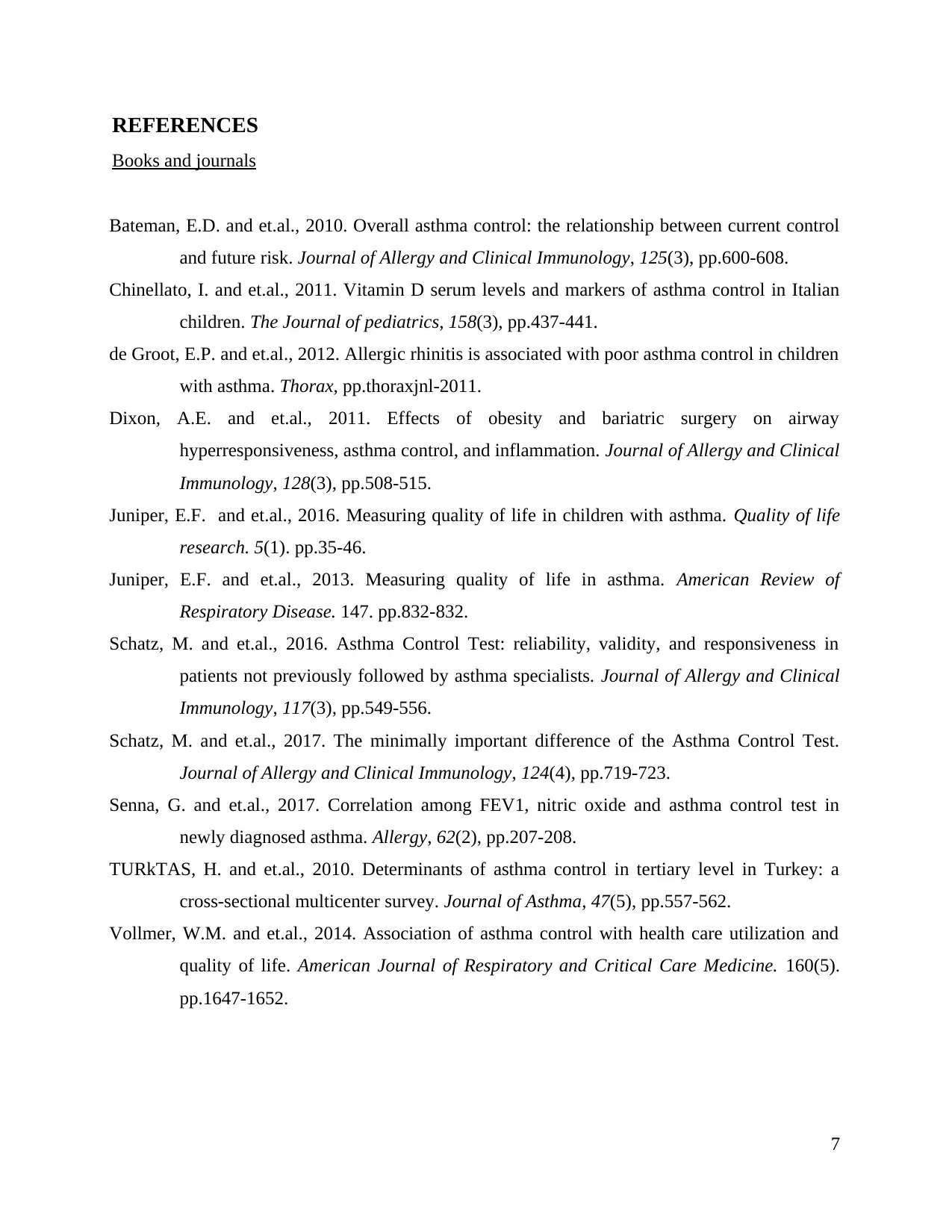
REFERENCES
Books and journals
Bateman, E.D. and et.al., 2010. Overall asthma control: the relationship between current control
and future risk. Journal of Allergy and Clinical Immunology, 125(3), pp.600-608.
Chinellato, I. and et.al., 2011. Vitamin D serum levels and markers of asthma control in Italian
children. The Journal of pediatrics, 158(3), pp.437-441.
de Groot, E.P. and et.al., 2012. Allergic rhinitis is associated with poor asthma control in children
with asthma. Thorax, pp.thoraxjnl-2011.
Dixon, A.E. and et.al., 2011. Effects of obesity and bariatric surgery on airway
hyperresponsiveness, asthma control, and inflammation. Journal of Allergy and Clinical
Immunology, 128(3), pp.508-515.
Juniper, E.F. and et.al., 2016. Measuring quality of life in children with asthma. Quality of life
research. 5(1). pp.35-46.
Juniper, E.F. and et.al., 2013. Measuring quality of life in asthma. American Review of
Respiratory Disease. 147. pp.832-832.
Schatz, M. and et.al., 2016. Asthma Control Test: reliability, validity, and responsiveness in
patients not previously followed by asthma specialists. Journal of Allergy and Clinical
Immunology, 117(3), pp.549-556.
Schatz, M. and et.al., 2017. The minimally important difference of the Asthma Control Test.
Journal of Allergy and Clinical Immunology, 124(4), pp.719-723.
Senna, G. and et.al., 2017. Correlation among FEV1, nitric oxide and asthma control test in
newly diagnosed asthma. Allergy, 62(2), pp.207-208.
TURkTAS, H. and et.al., 2010. Determinants of asthma control in tertiary level in Turkey: a
cross-sectional multicenter survey. Journal of Asthma, 47(5), pp.557-562.
Vollmer, W.M. and et.al., 2014. Association of asthma control with health care utilization and
quality of life. American Journal of Respiratory and Critical Care Medicine. 160(5).
pp.1647-1652.
7
Books and journals
Bateman, E.D. and et.al., 2010. Overall asthma control: the relationship between current control
and future risk. Journal of Allergy and Clinical Immunology, 125(3), pp.600-608.
Chinellato, I. and et.al., 2011. Vitamin D serum levels and markers of asthma control in Italian
children. The Journal of pediatrics, 158(3), pp.437-441.
de Groot, E.P. and et.al., 2012. Allergic rhinitis is associated with poor asthma control in children
with asthma. Thorax, pp.thoraxjnl-2011.
Dixon, A.E. and et.al., 2011. Effects of obesity and bariatric surgery on airway
hyperresponsiveness, asthma control, and inflammation. Journal of Allergy and Clinical
Immunology, 128(3), pp.508-515.
Juniper, E.F. and et.al., 2016. Measuring quality of life in children with asthma. Quality of life
research. 5(1). pp.35-46.
Juniper, E.F. and et.al., 2013. Measuring quality of life in asthma. American Review of
Respiratory Disease. 147. pp.832-832.
Schatz, M. and et.al., 2016. Asthma Control Test: reliability, validity, and responsiveness in
patients not previously followed by asthma specialists. Journal of Allergy and Clinical
Immunology, 117(3), pp.549-556.
Schatz, M. and et.al., 2017. The minimally important difference of the Asthma Control Test.
Journal of Allergy and Clinical Immunology, 124(4), pp.719-723.
Senna, G. and et.al., 2017. Correlation among FEV1, nitric oxide and asthma control test in
newly diagnosed asthma. Allergy, 62(2), pp.207-208.
TURkTAS, H. and et.al., 2010. Determinants of asthma control in tertiary level in Turkey: a
cross-sectional multicenter survey. Journal of Asthma, 47(5), pp.557-562.
Vollmer, W.M. and et.al., 2014. Association of asthma control with health care utilization and
quality of life. American Journal of Respiratory and Critical Care Medicine. 160(5).
pp.1647-1652.
7
⊘ This is a preview!⊘
Do you want full access?
Subscribe today to unlock all pages.

Trusted by 1+ million students worldwide
1 out of 9
Related Documents
Your All-in-One AI-Powered Toolkit for Academic Success.
+13062052269
info@desklib.com
Available 24*7 on WhatsApp / Email
![[object Object]](/_next/static/media/star-bottom.7253800d.svg)
Unlock your academic potential
Copyright © 2020–2025 A2Z Services. All Rights Reserved. Developed and managed by ZUCOL.




